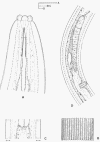 |
- Plump nematodes, 2mm long, body narrowing at anterior end; lip
region narrow.
- Cuticle very thick, 4-5 layers, with raised longitudinal
ridges. In body cross section, cuticle occupies almost 1/4 of
total diameter.
- Lip region strongly offset from body contour; lips separate.
- Amphids funnel shaped, apertures about half as wide as lip
region
- Odontostyle sinuate, about 2.2 x as long as labial diameter,
thinner than cuticle.
- Guiding ring simple and thin.
- Esophagus widening gradually at about 55% of its length.
- Five esophageal gland nuclei clearly visible.
- Female genital system diovarial, amphidelphic; vulva
longitudinal, not sclerotized.
- Male diorchic adanal papillae and about 15 contiguous ventromedian supplements.
- Spicules dorylaimoid
- Tail in both sexes short and bluntly rounded, with offset
recurved tip in females and juveniles.
Ref: Andrassy, 1998
|